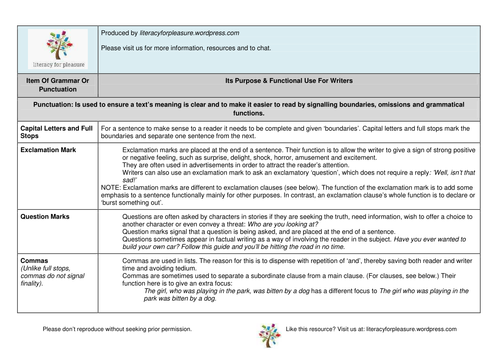

For more information, visit us here: https://literacyforpleasure.wordpress.com/
We made the Functional-Grammar-Table because we were fed up with texts which told you the rules of a piece of grammar but didn’t tell children (or indeed adults) why and where you might want to use it and the effect grammar can have on your writing. We were also fed up with the concept of ‘grammar deficit’. This is the teaching practice of continually passing judgement on rule errors in grammar-exercises as opposed to talking critically about what value grammar can have on writing or the effect of its absence has on the effectiveness of a piece. This realisation has transformed our practice. We explain how we now approach grammar teaching below:
Teaching Grammar Through ‘Writing Tricks’ Minilessons
What lessons will have a practical, lasting, positive influence on student writing? – Nancie Atwell
In many classes, minilessons precede daily writing lessons. Whether you’re teaching a grammar, writing-craft or genre study-point, it is useful to follow these stages:
Introduce the topic and its functional purpose ->
Share examples ->
Provide information ->
Guided practice ->
Assess learning.
Introduce the topic and functional purpose - This can be anything from a writing strategy or skill, grammar function or a literary genre concept. Always share the purpose and the function with the class, before moving on to formalities or rules.
- Share examples Look at examples from children’s or author’s real writing
- Provide information Provide information about the topic and how it can be used in ‘real’ writing. - Clarify misconceptions and contrast a good and a poor example to see how the writing is affected.
- Guided practice Children work individually or in pairs to practice what they are learning. Ideally this will be in the context of an authentic piece of writing a child is currently working on.
- Assess learning Teachers ask children to consider how they can use this information as they write. They can also reflect on their authentic use of it by leaving a comment in their book.
The Importance Of Giving ‘Writing Tricks’
Whatever you choose to do in these minilessons you should ensure that you teach in context and in a way that will empower children’s writing intentions. Calkins (1998, p.198) suggests that to successfully apply this attitude is to perceive minilessons as ‘quick tip’ giving before writing begins. This changes your perception of these lessons, stops them turning into exercises and instead creates a climate where children feel instructed in and taught something valuable.
We made the Functional-Grammar-Table because we were fed up with texts which told you the rules of a piece of grammar but didn’t tell children (or indeed adults) why and where you might want to use it and the effect grammar can have on your writing. We were also fed up with the concept of ‘grammar deficit’. This is the teaching practice of continually passing judgement on rule errors in grammar-exercises as opposed to talking critically about what value grammar can have on writing or the effect of its absence has on the effectiveness of a piece. This realisation has transformed our practice. We explain how we now approach grammar teaching below:
Teaching Grammar Through ‘Writing Tricks’ Minilessons
What lessons will have a practical, lasting, positive influence on student writing? – Nancie Atwell
In many classes, minilessons precede daily writing lessons. Whether you’re teaching a grammar, writing-craft or genre study-point, it is useful to follow these stages:
Introduce the topic and its functional purpose ->
Share examples ->
Provide information ->
Guided practice ->
Assess learning.
Introduce the topic and functional purpose - This can be anything from a writing strategy or skill, grammar function or a literary genre concept. Always share the purpose and the function with the class, before moving on to formalities or rules.
- Share examples Look at examples from children’s or author’s real writing
- Provide information Provide information about the topic and how it can be used in ‘real’ writing. - Clarify misconceptions and contrast a good and a poor example to see how the writing is affected.
- Guided practice Children work individually or in pairs to practice what they are learning. Ideally this will be in the context of an authentic piece of writing a child is currently working on.
- Assess learning Teachers ask children to consider how they can use this information as they write. They can also reflect on their authentic use of it by leaving a comment in their book.
The Importance Of Giving ‘Writing Tricks’
Whatever you choose to do in these minilessons you should ensure that you teach in context and in a way that will empower children’s writing intentions. Calkins (1998, p.198) suggests that to successfully apply this attitude is to perceive minilessons as ‘quick tip’ giving before writing begins. This changes your perception of these lessons, stops them turning into exercises and instead creates a climate where children feel instructed in and taught something valuable.
Something went wrong, please try again later.
Excellent-what I was looking for... 😀
Report this resourceto let us know if it violates our terms and conditions.
Our customer service team will review your report and will be in touch.
£0.00